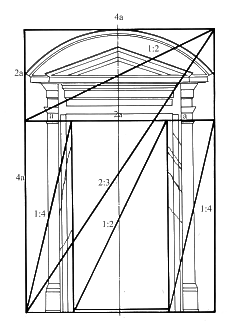
| Measuring up to Michelangelo: A Methodology |
|---|
RR1, Box 425
Randolph Center, Vermont 05061 USA
Via Mazzini 7
50054 Fucecchio (Firenze) Italy
In the fall of 1998, we began a new survey of Michelangelo's earliest built work of architecture, the New Sacristy of the Basilica of San Lorenzo in Florence, also known as the Medici Chapel. Kim Williams had surveyed the ground plan of the Sacristy in 1993 and found a recurring series of proportional relationships related to the root-2 rectangle. In order to establish a systematic use of root-2 proportions in the three-dimensional space of the Sacristy, the dimensions of the interior elevations of the space were necessary. The Sacristy had been surveyed by hand in 1939 by a group of students from the University of Florence under the supervision of Armando Schiavi. But because the 1939 survey contained dimensions that differed widely from Williams' 1993 surveyed dimensions, we had decided it was necessary to resurvey the entire interior using a theodolite and a trigonometric method devised by Paul Calter.
 At the same time
we were in Florence to survey the New Sacristy, Ben Nicholson,
who has spent many years studying Michelangelo's Laurentian Library,
also in the San Lorenzo complex, approached us about surveying
a doorway in the library. We were happy to comply, although due
to restoration work in the vestibule of the library, we were
unable to survey the doorway that Nicholson had requested. Instead,
we surveyed key dimensions of the portal on the opposite side
of the wall, that is, the portal that exits the reading room
and leads into the vestibule. What follows is a description of
our findings. Significant as they may be in terms of what they
reveal about Michelangelo's use of a proportional system, we
have organized the present paper in order to concentrate on a
methodology of obtaining data, organizing it, and estimating
its uncertainty. The intent is to begin to provide information
that may help establish standards relating to these tasks.
At the same time
we were in Florence to survey the New Sacristy, Ben Nicholson,
who has spent many years studying Michelangelo's Laurentian Library,
also in the San Lorenzo complex, approached us about surveying
a doorway in the library. We were happy to comply, although due
to restoration work in the vestibule of the library, we were
unable to survey the doorway that Nicholson had requested. Instead,
we surveyed key dimensions of the portal on the opposite side
of the wall, that is, the portal that exits the reading room
and leads into the vestibule. What follows is a description of
our findings. Significant as they may be in terms of what they
reveal about Michelangelo's use of a proportional system, we
have organized the present paper in order to concentrate on a
methodology of obtaining data, organizing it, and estimating
its uncertainty. The intent is to begin to provide information
that may help establish standards relating to these tasks.
ILLUSTRATION: Proportional rectangles showing the relationships between elements in the doorway from the reading room to the vestibule in Michelangelo's Laurentian Library.
ABOUT
THE AUTHORS
Paul
A. Calter
is a Visiting Scholar at Dartmouth and Professor Emeritus of
Mathematics at Vermont Technical College. He has interests in
both the fields of mathematics and art. He received his B.S.
from Cooper Union and his M.S. from Columbia University, both
in engineering, and his Masters of Fine Arts Degree at Vermont
College of Norwich University. Calter has taught mathematics
for over twenty-five years and is the author of ten mathematics
textbooks and a mystery novel. He has been an active painter
and sculptor since 1968, has participated in dozens of art shows,
and has permanent outdoor sculptures at a number of locations
in Vermont. For the "Mathematics
Across The Curriculum" program, Calter developed the
course "Geometry
in Art & Architecture" and has taught it at Dartmouth
and Vermont Technical College, as well as giving workshops and
lectures on the subject. He is the author of "How to Construct a Logarithmic
Rosette (Without Even Knowing it)"
in the NNJ vol. 2, no. 2 (April 2000) and presented "Facade
Measurement by Trigonometry" at Nexus '96, now available
in Nexus:
Architecture and Mathematics (1996).
Kim Williams, director of the Nexus conferences and editor of the Nexus Network Journal, is an American architect living and working in Tuscany. She received her degree in Architectural Studies from the University of Texas in Austin, and is licensed as an architect in New York State. She is the author of Italian Pavements: Patterns in Space (Houston:Anchorage Press, 1998) on the role of decorated pavements in the history of Italian architecture. She has published many articles on the use of mathematical principles in architecture and paving designs in journals such as Mathematical Intelligencer, Leonardo and Highlights for Children. Her research is supported by grants from the Graham Foundation for Advanced Studies in the Fine Arts and the Anchorage Foundation of Texas. At Nexus '96 she presented "Verrocchio's Tombslab for Cosimo de' Medici: Designing with a Mathematical Vocabulary", now available in Nexus: Architecture and Mathematics (1996).
|
Paul Calter and Kim Williams, "Measuring up to Michelangelo: A Methodology", pp. 23-34 in Nexus III: Architecture and Mathematics, ed. Kim Williams, Pisa: Pacini Editore, 2000. http://www.nexusjournal.com/conferences/N2000-CalterWilliams.html |
|
|
|
|
